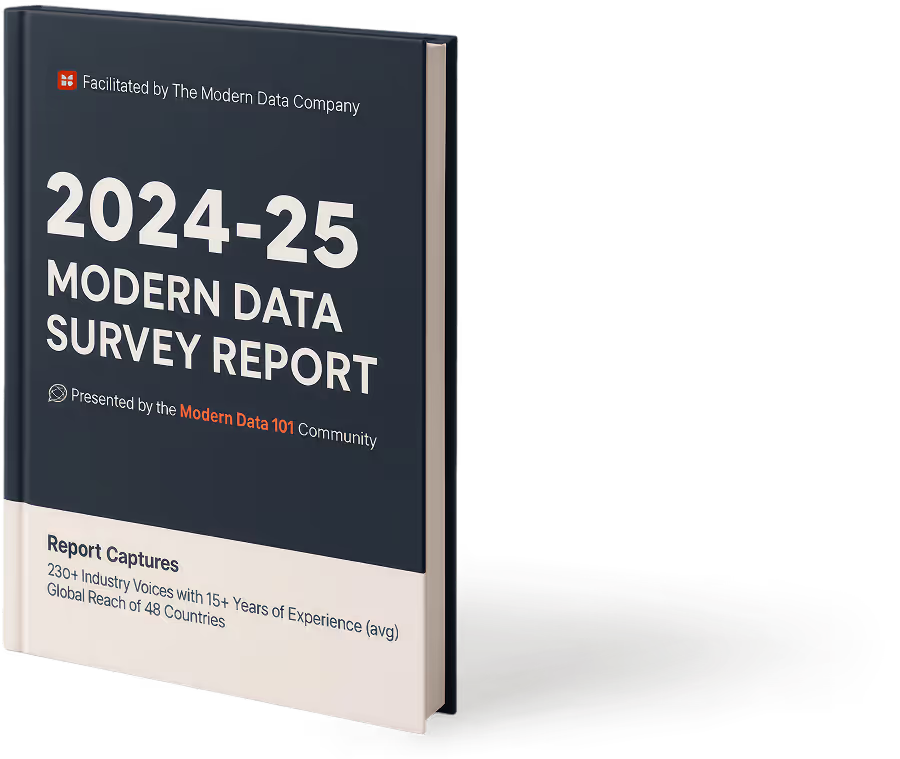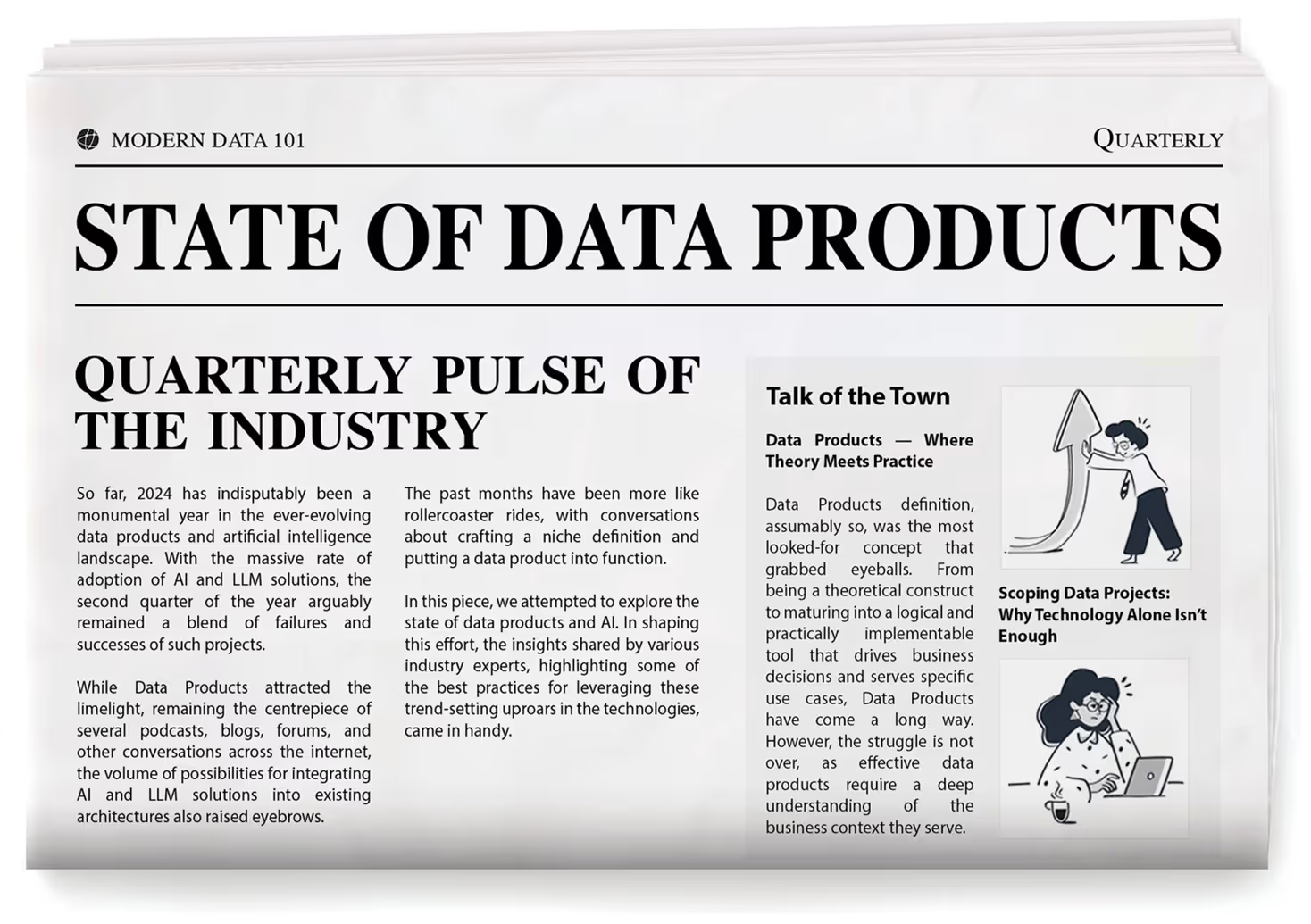
TL;DR
Have you ever felt lost in a huge library, though full of books, but finding that “one book” is almost impossible? Great, at least we are together in this. Most companies today have immeasurable data, or better known as “the new oil,” but just having huge data doesn’t help much. The real win rests in how the business turns the data mess into a data delight that’s truly useful, easy to find, and even fun to use.
This is where Data Products come in.
Revisiting Data Products
For now, let’s cut through the noise of fancy buzzwords and take a moment to understand: What exactly is a Data Product? Among all the hype and marketing, the essence of the value has been lost. The term has been saturated by proposing that the solution to everything data is in fact data products. When users find out that it is not the case, they lose trust in anything associated with the phrase. So here’s a simpler cut, no frills, to get back to the fundamental essence and not lose out on the opportunity of the product revolution.
What are Data Products?
In Data Mesh speak, a Data Product is an architectural quantum, which is the “smallest unit of architecture that can be independently deployed with high functional cohesion and includes all the structural elements required for its function.”

To put that in perspective, a Data Product is a purpose-built, trustworthy, and easily discoverable piece of data that's treated and managed with the same meticulous care and attention as any polished software application or physical product you might buy from a store. It's much, much more than just a dusty old table sitting forgotten in a database or a dashboard that occasionally throws a digital tantrum and breaks. Instead, picture it as a distinct, useful, and reliable output from a specific part of your business.
Its superpowers include being reusable (so no one has to reinvent the wheel, again!), reliable (you can trust its accuracy blindfolded), and discoverable (you actually know it exists and how to get your hands on it, instantly). It's data that’s truly ready for prime time.
To sum up,
A Data Product is an integrated and self-contained combination of data, metadata, semantics, and templates. It includes access and logic-certified implementation for tackling specific data and analytics scenarios and reuse. A data product must be consumption-ready (trusted by consumers), up-to-date (by engineering teams), and approved for use (governed). Data products enable various D&A use cases, such as data sharing, monetisation, analytics, and application integration. (Source)
Why are Data Products Becoming So Essential Today
Well, if the data at hand overwhelmed you by conflicting reports, making you spend endless hours cleaning data, or finding consistency in answers rather felt chaotic, you already know why. Data Products cuts through complexity and chaos.
It draws business away from the fragmented, hard-to-trust world of information to the one where data is organised, reliable, and genuinely actionable. This crucial shift empowers businesses to make smarter, faster decisions, truly moving from just collecting data to strategically leveraging it to drive success.
📌 Related Read *So I have a Data Product…Now What? ~* by Ryan Duffy, Data Management Strategy Leader
Intrigued? But wait, are you wondering,
How Exactly are These Data Products Built & Managed
Data Products have a dedicated lifecycle. From ideation and design, through building, testing, and launching, to continuous monitoring and improvement. This structured, disciplined approach makes Data Products so powerful. To execute this lifecycle effectively, and with consistency and precision, it needs dedicated teams and, crucially, very clear roles with well-defined responsibilities.
The Blurred Lines: Navigating the Data Product Leadership Landscape
The Problem
Ever came across job postings like, "Data Product Manager" & "Data Product Owner" and thought, "aren't those basically the same person?" If so, you're certainly not alone. Organisations find it hard to answer the same questions. The confusion is so prominent that at times, these terms are used interchangeably; other times, a brave soul is expected to use the magic wand they might not even have and embody both roles, stretching themselves thinner than a finely rolled pastry crust.
This IS NOT just a minor administrative detail; it’s a fundamental mix-up of two distinct, yet equally vital, leadership positions. To put that in perspective, it is like asking the Sales Manager to also do the work of a Marketing Manager.
The Consequence
This fundamentally goes wrong when these roles aren't clearly defined. Imagine trying to build a custom-designed vehicle where the person deciding what features it should have is also the one managing the daily assembly line and ordering individual bolts.
The situation is nothing but sheer chaos. Though one might end up with data products that look great on a slide deck but fail to solve real business problems, or brilliant ideas that never see the light of day. This eventually frustrates the team, effort is duplicated, and projects consistently miss their mark. The entire "data-driven" initiative becomes little more than a frustrating buzzword.
But hold your tears, as here is the good news!!
The Promise
Getting this distinction right isn't just about drawing those cute organisational charts or arguing over titles. It’s absolutely vital for building truly useful, impactful Data Products that genuinely move the needle for your business, and for fostering smoother, more efficient, and ultimately happier data teams. Clear roles come with clarity in responsibilities, laser-sharp focus, and a much higher chance of success for the Data Product initiatives.
The Strategic Visionary: The Data Product Manager (DPM)
Think of this: if the Data Product lifecycle were a grand expedition, the Data Product Manager (DPM) would be that seasoned explorer armed with a compass, map, and binoculars. They are on a mission that’s not just about building something. It is about figuring out answers to key questions like: why we're building it in the first place, and what it needs to conquer the highest peaks of business.
DPMs are the strategic brains and the ultimate champions of the Data Product's vision. Think of them as the CEO of their specific Data Product domain, charting the course for its success in the vast ocean of business needs.
So, what exactly DPMs have on their plate in a typical workday? Let’s understand a bit about their key responsibilitiesto paint a picture of the strategic depth and foresight they must possess:
User Research
They are on a constant look-out for opportunities, talking to internal business teams (and sometimes external customers) to understand their pain points, needs, and wildest of their data dreams. They translate vague requests into clear, valuable problems that need a solution.
Defining Product Vision, Strategy, & Roadmap
No, we do not mean just drawing lines on a whiteboard. The DPM crafts the overarching vision for the Data Products. Where it is going, what insights it mean to serve, and how it aligns with the broader company strategy. This vision is later translated into an actionable roadmap, a strategic blueprint showing the journey ahead.
Business Case Creation & ROI
No Data Product can function only on good intentions. The DPM builds a robust business case, clearly outlining the expected ROI. They are responsible for sketching how the Data Product will drive revenue, reduce costs, or unlock new business opportunities based on the case.
Stakeholder Management
Master communicators, constantly engaging with a diverse crowd: executives, CISO, CDO, Cloud Infra teams, ensuring governance, and even other Data Product Managers ( for e.g.: cross-functional or cross-domain Data Product usage. Data Products would need to frequently talk to each other, necessitating communication between DPMs.) They aim to ensure everyone is on-board and has a clear understanding of the value of the Data Product will be bringing.
Communicating Value
Beyond the technicalities, the DPM is the Data Product's chief evangelist. They drive its value proposition, celebrate its wins, and ensure its impact is understood across the organisation, making sure everyone knows why this Data Product matters.
Functional-Technical Collaboration
Understanding Data Platform landscape of the organization, to help in collaboration with the technical teams, like Cloud Infra, Database Administration, Data Engineering, to over see the process of curating data.
Viability Analysis
They keep an eye on what competitors are doing, what new technologies are emerging in the market, and how these emerging technologies can be leveraged to deliver enhanced Data Product experience.
To pull all this off, a DPM needs a set of required superpowers:
- Strong Business Acumen: They speak the language of business. They understand markets, financials, & operational challenges. They can connect data to real-world business outcomes.
- Strategic Thinking & Long-Term Vision: The next sprint doesn’t excite them much. They aim for the next year, two years, or even five years. They can anticipate future needs and position the data product for enduring relevance.
- Exceptional Communication & Storytelling: A DPM can explain complex data concepts to a non-technical executive and ignite excitement about a Data Product's real deal. They are compelling communicators, both verbally and in writing.
- Understanding of Data Ecosystems: While not necessarily a coder, they know how data flows, where it resides, and the technical challenges involved in building and maintaining the Data Products. This allows them to have credible conversations with Data Engineering and Platform Engineering teams and make informed decisions.
The Data Product Manager Profile can be understood as the true guiding star who ensures that every piece of data being built is pointed towards a clear, valuable business objective.
The Execution Maestro: The Data Product Owner (DPO)
If the DPM is the visionary architect mapping out the grand design of the Data Product, the Data Product Owner (DPO) can be thought of as the chief builder on the construction site. Their core mission is crystal clear: to bring the set strategic vision to life, tangible and working Data Products.
They are the tactical support or the backbone for the data initiatives, the daily problem-solvers, and the unwavering champions of the development team, ensuring that every brick laid is perfectly aligned with the overall blueprint. Think of them as the go-to person for the development team, ensuring the product gets built right, on time, and to spec.
So, wondering what a typical day of a DPO looks like? Their key responsibilities are oriented towards the tactical execution and seamless delivery:
Translating Vision into Actionable Items
When it comes to clarifying the 'what' and 'why' for Data Products, the Data Product Manager crafts detailed user stories that expresses what exactly is needed. Think of them as the chief architects who draw up the precise blueprints for the desired functionality.
The Data Product Owner then takes these DPM-defined user stories and gets down to the nitty-gritty. Their job is to break down these high-level user stories into concrete, tactical tasks. These decomposed tactical tasks are precisely what populate the team's backlog, ready for execution.
Managing the Backlog & Prioritisation
This is where the rubber meets the road. The DPO meticulously maintains and prioritises the team's backlog. They decide what gets built next, ensuring that the feature that brings the most valuable is always at the top on the priority.
Daily Liaison with the Development Team
A DPO is practically embedded with the data engineers, and other developers. They are the ones to get on the ground and get the clarity on questions, clarifying requirements, and ensuring the team has everything they need to proceed without getting stuck on the roadblocks.
Ensuring Technical Feasibility & Delivery Quality
While they might not be writing code themselves as well, the DPO holds a sharp understanding of the technical nuances and is aware of what's possible and what's not. They make sure that what's being built is technically sound, scalable, and meets the quality standards expected of a Data Product.
Accepting Completed Work
Upon completion of the pipeline, it is the DPO who reviews it, tests it against the initial requirements, and formally accepts it. They ensure that the delivery is exactly what was asked for.
Removing Impediments
Developers often hit hurdles. This could be a dependency issue, a missing piece of information, or even a blocked approval. The DPO is tasked with proactively identifying and swiftly removing these hurdles to keep development move smoothly.
To excel in this fast-paced, detail-oriented role, a DPO requires a unique blend of superpowers:
- Deep Understanding of Agile/Scrum Methodologies: This is where they like to play. A DPO breathes sprints, stand-ups, and backlog refinements. They are the ultimate masters of agile frameworks and work tirelessly to ensure the team's efficiency.
- Strong Technical Understanding: While not a coder, they speak the language of engineers. They have a sharp understanding of data models, pipeline complexities, and cloud infrastructure concepts well enough to make informed decisions and effectively communicate requirements.
- Attention to Detail & Problem-Solving: A DPO thrives on the details. They spot inconsistencies, foresee potential issues, and troubleshoot problems quickly to keep things on track.
- Team Facilitation & Organisation: They are expert organisers and facilitators, keeping the development team focused, motivated, and aligned. They balance the expectations and ensure clear communication within the team and with external stakeholders.
The DPO is the engine room of the Data Product, meticulously steering the daily development efforts to turn vision into a tangible reality.
The Dynamic Duo: How DPM and DPO Work Together for Data Product Excellence
Now we know enough about our two superheroes: DPM is the strategic visionary, and DPO is the execution maestro.
💡But here’s the Secret Sauce: Neither can truly succeed in isolation. Their collaboration is the heartbeat of successful Data Product development. Think of them as the perfect dance partners, each leading at different moments, but always moving towards a shared, striking performance.
Their relationship truly knows no rigid boundaries. While they operate on different horizons, the DPM looking out to drive adoption, and the DPO focusing on the sprint ahead. Their ultimate destination always remains the same: a Data Product that delivers undeniable value and delights its users.
Here’s how this dynamic duo typically co-pilots their data product to excellence:
Vision to Reality
The DPM paints the big picture (the "what" and "why"), rooted in business needs and market opportunities. The DPO translates this vision into actionable, bite-sized pieces for the development team (the "how" and "when"). It is a continuous loop, ensuring the big dream can actually be built.
Strategic vs. Tactical Prioritisation
The DPM navigates the long-term, strategic roadmap while the DPO manages the daily development backlog, making tactical prioritisation decisions to keep the team efficient and focused on immediate deliverables that align with the DPM's strategy. They constantly and regularly sync, ensuring the immediate actions contribute positively to the long-term goal.
Feedback Loops & Iteration
DPM gathers feedback from stakeholders and the data consumers (or users), bringing insights about unmet needs or shifting priorities. The DPO gathers feedback from the development team on feasibility, progress, and technical challenges, relaying those back to the DPM, thus creating a powerful and iterative cycle of continuous improvement and alignment.
Problem-Solving & Adaptability
When a problem arises from nowhere, this dynamic duo joins forces to nail a fitting solution. DPM provides the strategic context and weighs business impact, while the DPO works with the team to find the most practical and efficient solution, ensuring agility and quick adaptation.
Shared Success & Accountability
Ultimately, DPM and DPO share their wins. When a Data Product solves a business problem while delivering reliable insights and value, the combined effort pays off. Their individual tracks merge, forming a singular path to success, making both accountable for the Data Product's ultimate performance, value, and ROI.
In essence, the DPM ensures they are building the right Data Product, while the DPO ensures they are building the data product right.
When these two roles are clearly defined and work in complete synchronisation, data initiatives thrive, transforming raw information into a powerful engine for business growth.
DPM vs. DPO: A Quick Comparison (The Cheat Sheet)
Ok, if you are feeling like, “just take me straight to the point,” I must say, you're in luck. Here’s your Cheat Sheet on how these two crucial roles stack up side-by-side. Think of it as a handy guide to pinpoint who's doing what in your Data Product journey.

🏳️As you set your foot on distinctly understanding these two roles, let’s also discuss where they merge and why it must not be the case:
When Roles Overlap (and When They Really Shouldn't)
Clearly, the neat comparison table above might have given you a sigh of relief, but as we know, the real world is skilled enough to throw a problem that indeed calls for erasing these boundaries and bringing them together. There are situations where the lines between DPM and DPO can, and sometimes should, flex a little.
The Green Flags: Where a Healthy Overlap Can Occur
- Smaller Teams/Startups: In lean and agile environments, a single individual might genuinely walk on both the paths, or at least in the initial phase when the resources are tight. Combining roles is often a necessity and a smart decision when it is coupled with acknowledgement for the breadth of responsibility and genuine efforts to avoid burnout are being made.
- Early-Stage Data Products: When a data product is still finding its feet, the DPM might get more hands-on with early execution just to validate the vision and ensure the initial foundational pieces are exactly as intended. The DPO might lean into more strategic conversations as the product's market fit is being explored.
- Close Collaboration: Even with a clear distinction, DPMs and DPOs are regularly coming together to stay aligned. There is a natural overlap in their shared understanding of the product. A DPM might jump into a technical discussion to clarify a business need, and a DPO might offer insights on market trends based on what the data team is looking at.
The Red Flags: Where Overlap Becomes a Problem
- Loss of Focus: If one individual consistently tries to juggle between both the macro (strategy) and the micro (daily tasks) tasks for a mature Data Product, the process might break. The long-term vision might get neglected, or the daily execution will become sloppy. It's like trying to navigate a ship across an ocean while simultaneously scrubbing the deck – neither of the jobs gets done in the first place, forget done well.
- Lack of Accountability: When roles are blurred, accountability becomes a challenge. If a data product isn't performing, who truly owns the "why" (DPM) versus the "how" (DPO)? Blame games can easily sneak in, hindering progress and fostering resentment within the team.
- Slower Delivery: If the DPM is constantly bogged down in sprint details, they can't do their core game: Strategise. If the DPO is trying to figure out market fit instead of guiding the development team, the delivery halts. Clear separation optimises speed and efficiency.
- Burnout: Expecting one person to fulfil both demanding roles, especially as a Data Product matures, is a perfect plot for quick and frequent burnouts. These are two full-time jobs requiring different skill sets and energy.
The trick is to recognise that while some communication and knowledge-sharing is beneficial, a structural overlap where one person consistently performs both roles for anything but the simplest Data Products might be an invitation to chaos.
Final Note: Clarity Paves the Way for Data Products’ Success
So, there we are. The Data Product Manager and the Data Product Owner are not and should not be used interchangeably. They are distinct, yet complementary forces, each bringing unique strengths to the table to ensure data isn't just collected, but truly transformed into valuable, actionable products.
The DPM is the compass, charting the course by understanding the market and defining the vision. The DPO is the engine, meticulously building and delivering that vision with precision. When these two roles are clearly defined, understood, and allowed to operate within their distinct, yet collaborative spheres, data initiatives stop being a source of confusion and become a powerful engine for innovation.
FAQs
What is the difference between a Data Product Manager and a Data Product Owner?
A Data Product Manager (DPM) is responsible for the overall vision, strategy, and success of a data product, often aligning business goals with technical possibilities. In contrast, a Data Product Owner (DPO) typically focuses on the execution side: managing the backlog, prioritising tasks, and ensuring development aligns with user needs. While the Manager sets the “why” and “what,” the Owner handles the “how” and “when.”
Can a Data Product Manager and Data Product Owner be the same person?
Yes, in smaller organizations or early-stage teams, one person may perform both roles. However, as the complexity of data products and teams grows, separating these roles helps streamline decision-making, clarify responsibilities, and improve cross-functional collaboration between business and engineering teams.
Why are both Data Product Managers and Data Product Owners critical for data product success?
Data Product Managers ensure that data products deliver strategic value, while Data Product Owners ensure those products are built efficiently and meet user requirements. Together, they bridge the gap between business strategy and technical execution, ensuring that data products are not only useful but also usable and scalable.
Join the Global Community of 10K+ Data Product Leaders, Practitioners, and Customers!
Connect with a global community of data experts to share and learn about data products, data platforms, and all things modern data! Subscribe to moderndata101.com for a host of other resources on Data Product management and more!
.avif)
A few highlights from ModernData101.com
📒 A Customisable Copy of the Data Product Playbook ↗️
🎬 Tune in to the Weekly Newsletter from Industry Experts ↗️
♼ Quarterly State of Data Products ↗️
🗞️ A Dedicated Feed for All Things Data ↗️
📖 End-to-End Modules with Actionable Insights ↗️
*Managed by the team at Modern



Author Connect 🖋️

Swami Achari

News, Views & Conversations about Big Data, and Tech

Nikhil Singh

News, Views & Conversations about Big Data, and Tech





%20(1).png)




